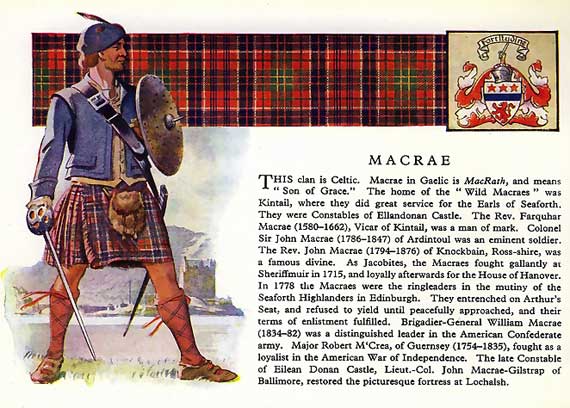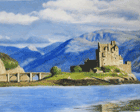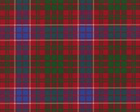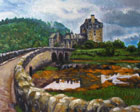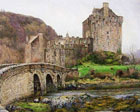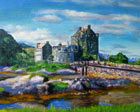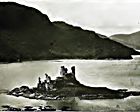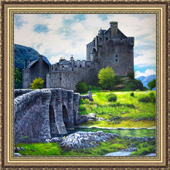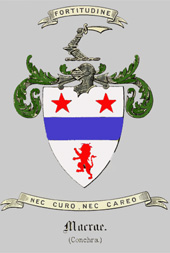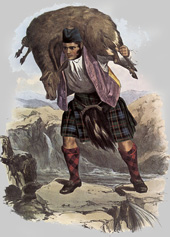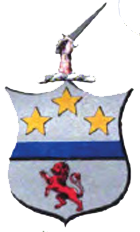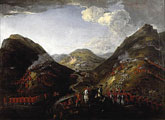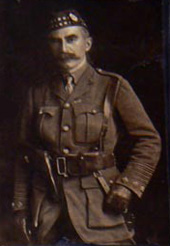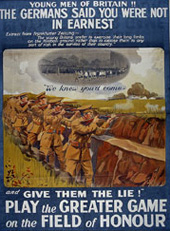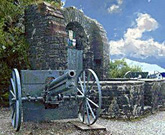- Clan Name: MacRae
- Clan Motto: Fortitudine
- Clan Seat: Eilean Donan Castle
- Castle Location: Loch Duich, Scotland
- Clan Lands: Beauly, Kintail.
- Plant Badge: Alpinum - savin leaved club moss
Clan History
There are mentions of a Clan MacRae taking part in the Battle of Largs in 1263 against King Haakon of Norway. Around that time there is evidence of MacRae's, or MacRath, living in Clunes and around the area to the north-east of Loch Ness. The lands were owned by the Bissett family of Lovat. They co-existed in harmony.
In the early 1300's the chief of the Bissett's died without a male heir and on the marriage of his daughter to a Fraser the lands changed hands.
About that time an Ian MacRae set out and ended up in Kintail on the west coast near Skye. This was the start of what was to end up as the main line.
Kintail was controlled by the MacKenzie clan who were fast gaining lands and power at that time. Over the next two hundred years the MacRaes were joined by other families of their clan from old Lovat lands and were most numerous around the Kintail area and Inverinate in particular.
The clan thrived in the area and fought alongside the MacKenzies. They earned their place and lands by giving armed support in joint defence. Specialising in archery they were a welcome addition to the larger clans arsenal.
The 16th and 17th century was when the MacKenzies were at their peak. Taking on all who dared they controlled a strip of Scotland from east to the west coast.
Eilean Donan castle was their stronghold on the east coast and under constant harassment. In 1509 the MacRaes were en-trusted with the position of Constable of Eilean Donan to ensure the safety of the stronghold and protect and defend the surrounding areas.
In 1539 the castle was under siege from the MacDonalds. Their chief Donald Grubach was intent on restoring lost power. At that time it was being defended by only two men and a boy. The constable, Christopher MacRae was killed but when a barbed arrow struck in the foot of the MacDonald chief he ended up bleeding to death and that brought the siege to an end.
The MacRaes were hereditary Constables of Eilean Donan and Chamberlain of Kintail for most of the next 200 years.
The Clan supported the Royalist side in the Civil War taking part in the Battle of Auldearn in 1645 under James Graham.
The Clan were also faithful to the Stuart cause and came out to support the Jacobites at the Battle of Sheriffmuir in 1715. Unfortunately although the Earl of Mar, commander of the Jacobites, had vastly larger forces than John Campbell Duke of Argyll who controlled the government side, the battle ended inconclusively. The way the battle played out saw the Macraes taking most of the fatalities.
The MacKenzie 5th Earl of Seaforth had raised 3,000 men for this venture and ended up fleeing to France and having his estates forfeited. This was probably the start of the lowest ebb for the clan. Another factor tried to collect the rents on the estate unsuccessfully. The 5th Earl returned in time for Glen Shiel where he was severely wounded.
The Battle of Glen Shiel in 1719 and destruction of Eilean Donan.
During the years of 1688 to 1746 there were a number of Jacobite uprisings, rebellions and battles fought throughout Britain. The aim was to return the Stuart blood line to the British throne. The two largest conflicts were in 1715 and 1745. The 1745 ended with Culloden in 1746 which put an end to the cause.
This battle came about on the 10 June 1719. Due to external politics the Jacobites had gained a new ally in Spain. George Keith, the 10th Earl Marishal of Scotland, who was forced to flee after the 1715 uprising and ended as Jacobite ambassador to Spain had hatched a plan where he would land in Scotland with 300 Spanish marines to raise the clans and draw the British forces north. Meantime an armada of some 27 ships and 7,000 men were dispatched to land in England.
Unfortunately the armada failed to arrive and although Keith landed on the 13 April 1719 near Eilean Donan at Lochalsh, he didn't get the Clan support that he had hoped for. After more than a month of trying to raise support they decided to start things off with capturing Inverness. Altogether there was around 200 of the Spanish together with some Atholl men, Mackenzies, MacRaes, Lochiel and the Camerons, and Rob Roy MacGregor with some of the MacGregor clan in total about 1,000 men under the leadership of the Earl of Seaforth.
S At the beginning of May 1719, government sources had heard of a landing and sent a naval squadron to the area to investigate. The castle at this time was manned by a Scotsman, an Irishman and 39 Spanish soldiers left behind from the main force.
On the 10th May 1719 three British Royal Navy ships entered Loch Duich and anchored near Eilean Donan. The lead ship was the 50 gun Man-o-War HMS Worcester together with the 25 gun frigates HMS Enterprise and HMS Flamborough. They first sent in a small boat with a flag of truce, to negotiate surrender but were met with cannon shot from the castle. The navy then proceeded to bombard the castle which was out-gunned by about 100-2 cannons. The next day the navy captured the Spanish and demolished the rest of the castle.
On the 5th June a force of about the same size but much better equipped seasoned British troops including contingents from the Clan Fraser, Clan Ross, Clan Sutherland, Clan Munro and Clan Mackay had left Inverness to stop them.
The two sides met on the 10th in the narrow gorge of Glen Shiel.The Jacobites after losing around 100 men, decided it was better to live and fight another day and melted into the mists.
In 1741 Kenneth MacKenzie, son of the 5th Earl was allowed to buy back some of the MacKenzie estates.
The MacRae Clan, as a whole, did not take an active part in the remaining Jacobite rebellions although individual groups set off for Culloden, never to return.
Apart from their prowess at warfare the MacRaes were also known for their poets and clergy.
If I were to tell the story of any notable clansmen then the exploits of Lt Col Sir George McCrae in the first world war stands out. In the early stages of the war it was decided to keep football fixtures going to keep up the public spirit. However by the end of 1914 the war was starting to consume a large number of lives when the powers that be kept wasting lives forcing the men to charge machine guns.
George was a local businessman and Member of Parliament for Edinburgh. He answered the call and started raising a new battalion. Speeches and bagpipes raised 800 volunteers in seven days. George's "I would not, I could not, ask you to serve unless I share the danger at your side. In a moment I will walk down to Castle Street and set my name to the list of volunteers. Who will join me?" given at the Usher Hall in November had mothers trusting him with their sons.
The full football team from Hearts of Midlothian, players from Hibs, Raith Rovers and Dunfermline together with golfers, rugby players and their fans joined up en-masse. It became known as the The Sporting Battalion, MacRae's Battalion, officially the 16th Royal Scots.
After training the Battalion were moved to France and their first full engagement was July 1st 1916, the opening of the Battle of the Somme. At 0728 hours they were ordered to fix bayonets. At 0730 the whistles blew...and the slaughter began. The darkest day in British military history.
20,000 men died that morning, 40,000 were wounded. The cream of their generation. Including 12 officers and 600 men from the MacRaes who gave their lives "for their Country".
George who was 54 years of age, had stayed true to his word, and was in the thick of the fighting with his men. He was wounded and physically broken and sent home. The battalion was disbanded shortly afterwards with 1400 having paid the ultimate price. By the end of the war there was only 36 survivors of the original MacRaes Battalion.
When George died in 1928 at the age of 68. His funeral was the largest ever witnessed in Scotland. Businesses closed for the day, traffic was suspended and Edinburgh came to a standstill with thousands of mourners lining the streets. Remembering not only the man but the sacrifice.
While on melancholy topics another would have to be the touching poem penned by Major (surgeon) John MacRae at Ypres in 1915.
IN FLANDERS FIELDS
In Flanders fields the poppies blow
Between the crosses, row on row
That mark our place; and in the sky
The larks, still bravely singing, fly
Scarce heard amid the guns below.
We are the Dead. Short days ago
We lived, felt dawn, saw sunset glow,
Loved and were loved, and now we lie
In Flanders fields.
Take up our quarrel with the foe:
To you from failing hands we throw
The torch; be yours to hold it high.
If ye break faith with us who die
We shall not sleep,
though poppies grow
In Flanders fields.
Eilean Donan lay in ruins for 200 years until purchased by a Colonel Macrae-Gilstrap a descendant of the last MacRae constables of the castle. He spent from 1912 until 1932 reconstructing the castle and building it into what can be seen today.
